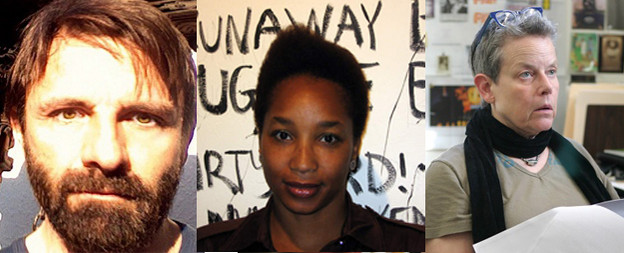On QED II, part one: The presence of absence

QED II: The Presence of Absence
For the past two years, Les Figues Press has hosted the series Q.E.D., a three-part event named for Gertrude Stein’s Quod Erat Demonstrandum. Stein’s coming-out text, written in 1903, was suppressed at her request until its posthumous publication in 1950. Hence the appropriate title for the first Q.E.D. II 2013: The Presence of Absence. Each Q.E.D. panel this year featured a Les Figues Press author, two artists or writers their work is in conversation with, and a moderator. For the first event, Matias Viegener selected Tisa Bryant and Catherine Lord. Anna Joy Springer moderated.
Matias Viegener began the discussion with a quote (borrowed from panelist Catherine Lord) from Dodie Bellamy’s blog: “Queer celebrates poverty of theory. Make own stories out of gaps and silences.”[1] In his curatorial statement, Viegener asks: “How indeed is the queer subject, the subject of the other, to be made present? What are the axiomatics of delivery? Are there other kinds of presence that are structured by forms of absence?”
Viegener thus structured the conversation around two salient questions: firstly, is there a lack within theoretical discourse that leaves out the kinds of gaps or silences that characterize erasure, or absence? Secondly, what kind of alternate axiomatics of delivery might be able to contain this absence in order to give it a kind of presence? I wonder if the “poverty” here is connected to Lord’s assertion, also recorded in Bellamy’s essay, that Lord “squirm[s] at the accusation of scholarship.”[2]If the notion here is that theory somehow leaves behind the daily details of experience, Matias may have provided a provisional answer in the selection of writings he read from.
The collection 2,500 Random Things About Me Too, 100 “twenty-five things about me” lists, was written entirely on Facebook.[3] In this work, queer subjectivity is assembled in mosaic form, from precise fragments. While the “things” often seem random, the passages Viegener selected brought to the forefront questions of how a self can be constructed against and with collective and individual histories of grief. Is this possibility contained in the (present) detail that might somehow call up the (past) trace?
Theory might say something similar. Benjamin, collecting fragments for his Arcades Project, quotes Horkheimer on the “incompleteness of history”: “The determination of incompleteness is idealistic if completeness is not comprised within it. Past injustice has occurred and it is completed.”[4] There is an index of grief, untouchable from the present, that must be reckoned with. Of course, this “completeness” of irreversible wrongs done does not foreclose the possibility of creating new narratives. It might be this latter absence that the detail, in the present, might help us find our way back to, but it is equally possible that the opposite should happen — that confronting the gaps and silence of the past might allow us to build a new “presence” in the present. This would mean, perhaps, that theory might also be a useful tool in constructing queer stories.
This sense of simultaneous recoverability and the irrevocable, of being both too late and right on time, permeated Tisa Bryant’s reading. Cataloging time spent in the Lorraine Hansberry archive, Bryant speculates about the movies Hansberry wanted to make and never could. Bryant also spoke of the archival materials she wasn’t allowed access to, those that contained the materials pertaining to Hansberry’s love life. “To whom,” asked Bryant, “does the depth of her absence belong?” Bryant constructs a narrative about the kind of movies Hansberry would have made, but we won’t ever see them. Bryant may have found evidence, she said, of what she had been told never existed — a black female filmmaker from the ’50s and ’60s — but when she found one, this filmmaker had never made a film (A Raisin in the Sun, she pointed out, is by no means the film Hansberry wanted to make). What has been lost in some tangible form is the work of art itself. Bryant recovers all that she can, but her work also insists on the way in which mourning must necessarily accompany any attempt at constructing a presence built from the so-called “refuse of history.”[5]
In a similar vein, Catherine Lord projected images from To Whom It May Concern on the wall of the Schindler house, where the series was held. The project consists of photographs of dedication pages Lord and her assistants culled from the ONE archive. The images cycled through at an irregular rate, making some more ephemeral than others. Some names were recognizable, others not. Initials, homages, and messages to “friends” prevail. Again, we were confronted both with the experience of beauty — what was there — as it pressed against what was lost in its unspeakability. Under these circumstances, research, as Bryant noted, turns into a “question rather than an answer.” Or, as Lord put it, by refusing to name names, she is able to generate a “bad history” of unmoored affect. This rejection of naming, however, is not a rejection of individual bodies — as Lord put it, the sense of the “DNA” on the books she photographed “enables a ghost.”
This idea of enabled ghostliness, a surging up of the past through a detail, might serve to answer Viegener’s opening question regarding the “axiomatic of delivery” of the presence of absence. However, this is not merely a question of letting a hidden past emerge, but also of allowing a “bad history” to emerge both in what is constructed from the past and in a simultaneous reconsideration of the present. To become unmoored is to allow the random, the nameless, and the speculative to take their place.
1. For Dodie Bellamy’s remarks, see Open Space.
3. Matias Viegener, 2,500 Random Things About Me Too (Los Angeles: Les Figues Press, 2012).
4. Walter Benjamin, The Arcades Project, trans. Howard Eiland and Kevin McLaughlin, ed. Rolf Tiedemann (Cambridge, MA: Belknap, 1999), 471.